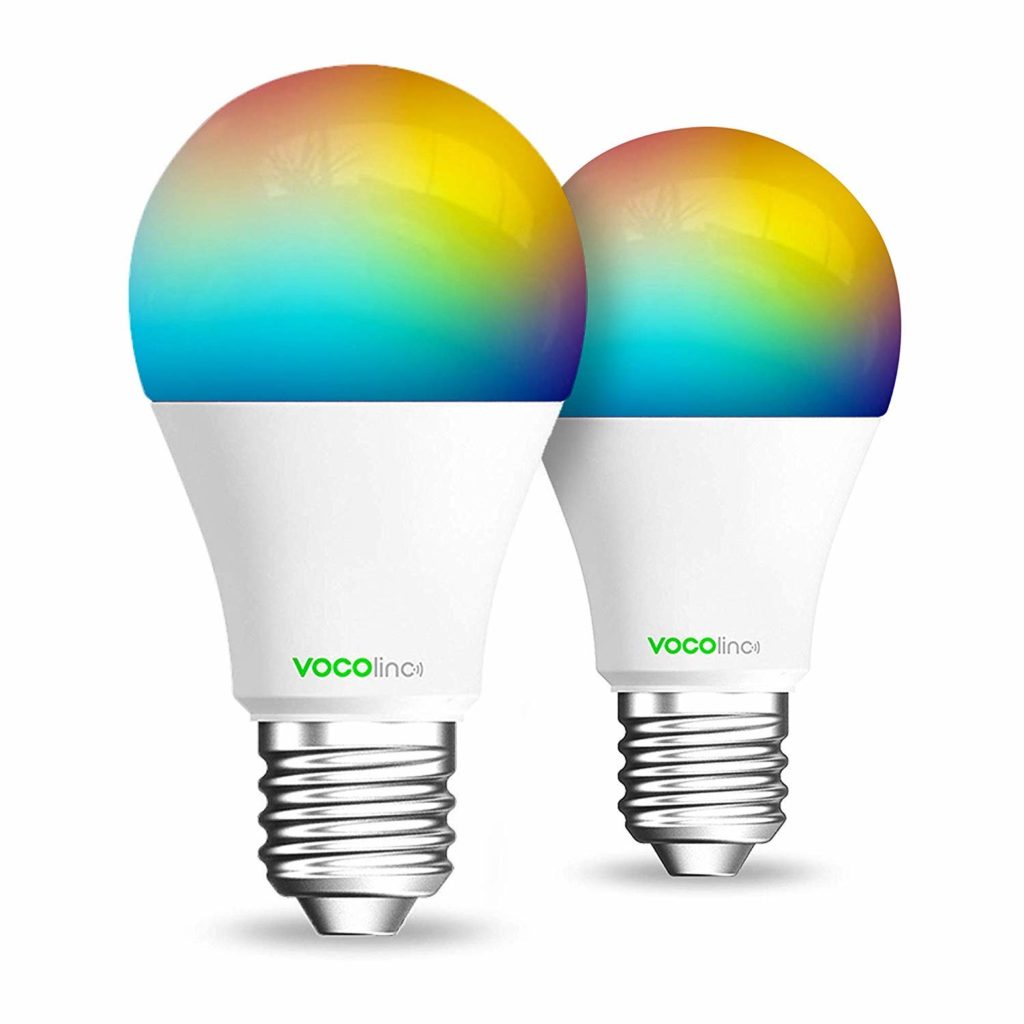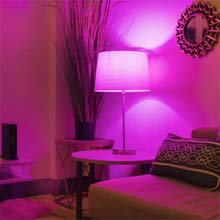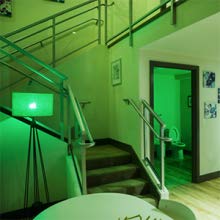In 2019, the market is seemingly flooded with a veritable plethora of connected lighting that come in all sorts of shapes and sizes and as the market grows, the consumer benefits with a selection of more cost-effective options. Smart lighting is a great way to not only get started with home automation, but also to add some decorative elements to your home. Apple’s HomeKit allows us to bring together different manufacturers’ products into one pretty seamless experience letting us pick and choose what is most appropriate for our needs. This review will look at VOCOlinc’s WiFi-connected A19 color bulb and we’ll see how it stacks up and hopefully help you to make a more informed purchasing decision.
A review unit was provided to myHomeKithome for the purpose of this review, but no compensation was received nor was the content reviewed before publishing. All thoughts expressed are purely those of my own.
Features
- 16 million colors
- Smart features via LinkWise app include lighting effects and scheduling via the LinkWise Cloud
- Apple HomeKit integration (requires a Home hub for Apple’s Home app remote access and automations)
- Also works with Google Assistant and Amazon Alexa
Need to Knows
- A19/E26/E27 bulb base
- 470 lumen brightness (40W incandescent equivalent)
- 2400 – 5300K daylight range
- Avg. 6W energy consumption
- Requires a 2.4 gHz WiFi band
Pros
We don’t usually think about design and aesthetics when it comes to light bulbs, but as the world moves away from incandescent and CFL models to more energy efficient LEDs and smart LEDs, size, weight, and shape are something we have to take into account. The VOCOlinc L1 boasts a pretty minimal footprint and I would say doesn’t take up any more space than a standard LED bulb making it suitable for most lamps and fixtures.
Admittedly, I wasn’t exactly thrilled reading the specs on this bulb with it coming in at a brightness of 470 lumens and a rated 6W energy consumption, but screwing it in, flipping the switch, and going through the spectrum of different colors, I was a little impressed. The color representation and saturation are relatively decent especially looking at blues and purples, but reds come across to me more like oranges and, not surprisingly, greens seem blown out.
When deciding on smart lighting for your home, of course we need to consider how much lighting we want now and in the future, but we also need to think about how we want that lighting to connect. One of the great things about the VOCOlinc L1 bulbs is that they do not require a centralized hub in order to connect to your smart home. This is particularly great if you have decided to go the route of smart switches for most of your lighting needs, but want to add touches of color throughout your home. However, if you are thinking about expanding your HomeKit setup, you’ll want to be conscious about how many clients your WiFi router can manage and what you are planning to do in your connected home.
Though personally, I am a bit of a HomeKit purist preferring not to have to juggle 45 million apps and talk to different digital assistants for different tasks, as a smart home enthusiast, I am an inclusivity as is VOCOlinc. Most of their lineup of connected home offerings, including the L1, not only support HomeKit, but Google Assistant and Amazon Alexa giving us ultimate flexibility if one day we. Decide to throw caution to the wind and choose a different connected home platform.
Cons
In recent years, LED bulbs have come WAY down in price and this includes smart LEDs, but they are not without their drawbacks. While LEDs are very capable of outputting light to blind the world, this usually comes at a pretty steep price tag. Even arguably the heaviest hitter in the smart lighting game, Phillips Hue, continues to struggle with manufacturing LED bulbs that deliver the luminous flux, but keep cost down and this too, is a challenge experienced by VOCOlinc and their L1 color LED bulb. The bulb is great for decorating with different color tones, but if you’re looking to this bulb as a primary light source, you may be disappointed.
As recommended before attempting setup, I performed a factory reset on the bulb and I even made a video about how to do it if you too want to know how to do this.
When trying to set up the bulb using the LinkWise app, I wasn’t able to get past the initial screen that reminds us of the things we’ll need in order to do so. As is sometimes the case with some WiFi accessories before setting up, I connected to the L1’s WiFi network via my iPhone’s settings, but still nothing in the LinkWise app. To remedy this, I just hopped over to Apple’s Home app and added the accessory there and I had no issue at all and after doing so, the bulb appeared in the LinkWise app as if it had been there all along.
Though not a consistent issue nor did it affect our testing, just after setting up and updating the firmware for the bulb, I noticed that it disconnected from my WiFi network a few times. This is likely a result of the firmware update itself, I did want to mention it as this might happen to you. The problem usually works itself out but if it doesn’t, turn off the bulb for 10 or 15 seconds and then turn it on again and see if it reconnects before calling a code red and resetting the bulb or phoning customer service.
The App

I’ll just come out and say that I am a fan of the LinkWise app for its lineup of lights. While the UI isn’t my favorite, the team at VOCOlinc has made great strides to bring added features and benefits for many of their products in particular their lighting products. Equally as impressive is that VOCOlinc constantly works to improve the user experience and regularly releases updates to the app and the firmware of their products as well. They are definitely not resting on their laurels in this regard.
VOCOlinc’s lighting products have a few built-in lighting effects available through the LinkWise app. For the L1, and their other color lighting products, we can choose from Breathing, Flashing, and Smoothing lighting effects and we are able to adjust the colors included in the effects in addition to the interval rate and brightness. Unfortunately, these lighting effects can only be applied to VOCOlinc’s lights, but one really interesting thing is that these lighting effects, whether intentional or not, can hackishly be ported into HomeKit as scenes and used in automations. Here’s how to do it:
Final Thoughts
A side effect of LED lighting becoming more popular is that since it’s relatively inexpensive to run interns of energy, we are now able to decorate with light. Strategically placed colored lighting accents can add a dramatic flare and turn an otherwise boring house plant into a focal point and the VOCOlinc L2 color bulb can help you achieve this and much more. These effects can be even more impressive with the different lighting effects provided in the LinkWise app and can help set the mood for any number of social soiree you may have on your docket. In term of day-to-day functionality, this bulb is really as solid as they come in my experience. I do wish it were a little brighter and that some of the colors were a little more intense but for the price, you can’t go wrong with this bulb.
In what ways have you use smart lighting to brighten up your HomeKit home? Do you say “nay” to smart bulbs in general and go with smart in-wall switches instead? Tell us all about it in the comments down below. Follow us on Facebook, Twitter, and Instagram for more HomeKit treats @myhomekithome.
Links & Resources
Find out more about VOCOlinc’s lineup of HomeKit-compatible products at https://www.vocolinc.com
We use income-earning affiliate links.
We may receive a small commission on purchases made using links on this page at no extra cost to you.




